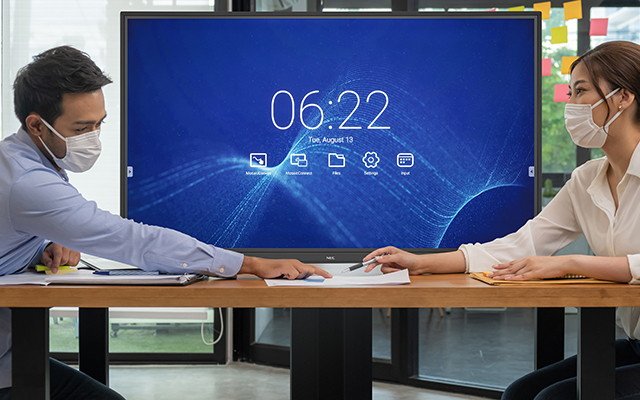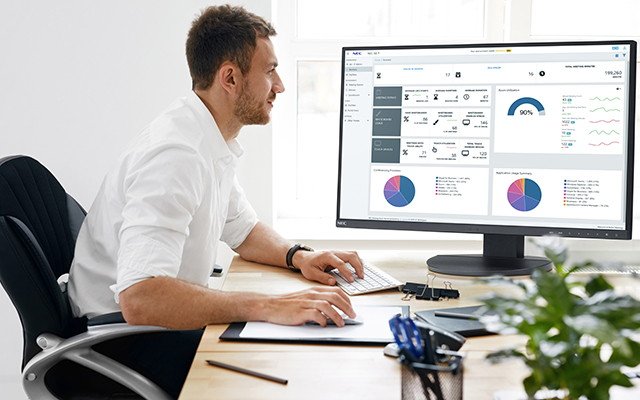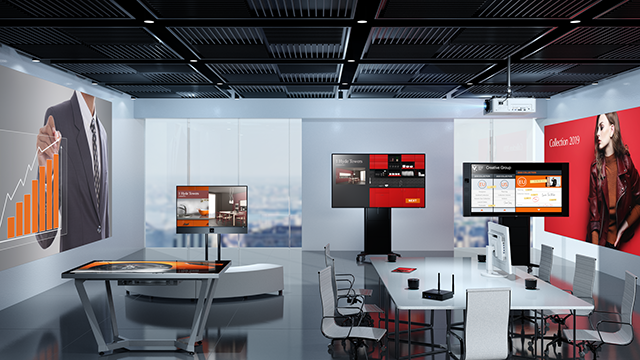What will meetings look like in 2021?
6 tips to getting your meeting rooms prepped for business
Coronavirus-related lockdowns will continue to impact our working lives long after the crisis has passed. While some of the effects from this long period of working from home may surprise us, some are easy to foresee. Simon Hayes, NEC’s meeting space and collaboration specialist, urges organisations to take the time now to prepare for those changes.

Even before the crisis, businesses were trending towards flexible and remote working. The productivity, health and lifestyle benefits of remote working will still be valid after the crisis, and the entire workforce will have had experience of working remotely.
The lockdown experience can be viewed as equally beneficial to businesses - even the most reluctant companies now know what can be done remotely. However, the most enthusiastic advocates of remote working recognise the importance of face-to-face connections. If you’ve noticed your tech-enthused co-workers speaking about the office with a bit of longing, you’re not alone.
To adequately plan for the future, businesses will need to take both preferences into account. It is likely that more employees will want to work from home more frequently. However, physical meetings will continue to be an important part of everyday. A significant post-covid shape shift in the business world will be that almost every physical meeting will include participants joining remotely.
Face-to-face will prevail
Many of us have realised that there is something about meeting face-to-face that cannot be replicated with virtual meetings or instant messaging applications, despite how useful these technologies have been to our productivity. Perhaps it is the more formal nature of in-person meetings or the ability to read people’s body language and judge their engagement.

Clever businesses will find a way to balance remote and in-office work. The best way to do that is to make sure in-person meetings feel worth the time. Businesses should give sufficient thought to creating meeting spaces that can support productive working for everyone in the room. It’s easy to think that a great meeting space is all about the latest displays hooked up to the WAN, using the latest collaboration software. The fact is, creating a space that’s conducive to productive working is so much more.
In-person meetings will prevail but post-covid they will almost always have remote participants - not everyone will be able to, nor want to be, in the office at the same time. So technology needs to enable this and it needs to be as simple as connecting from a laptop at home. To ensure the same experience, new meeting spaces must be as frictionless as possible.
Optimising space

First, find a dedicated space. Given the high cost of real estate, it may not be possible to give a room over solely for meetings. Some businesses need to consider how they can quickly convert a room into a suitable meeting space without taking much-needed space away from other workers.
Even businesses with multiple conference rooms often find that space is at a premium. Analytics tools such as NEC’s Room Management Service (RMS) optimise room usage so that every second of room time can be put to good use. This also provides input for infection control measures, triggering cleaning teams to sanitise the room between users.
Space is only one of a number of considerations that must be taken into account when equipping offices to support and encourage collaboration. The following tips identify the key considerations for businesses as they select and provision meeting rooms.
Six tips to getting your meeting rooms prepped for business
Fixed or flexible spaces – First, decide if you have the space for a dedicated meeting room, or whether cost and space concerns mean you’re better off with a flexible multi-purpose space. This will depend to an extent on your corporate culture, how often you have meetings, and whether these tend to be internal or with outsiders. A more flexible arrangement will enable businesses to quickly adapt and manage spaces in line with government guidelines which are constantly changing in the current Covid climate. These considerations should inform the technology you choose.

Furnishings – Important as it is to select the right technology, it’s also critical to get the look and the feel of the space right. An airless, windowless box with drab décor and uncomfortable chairs will make meetings a penance. Select the right furniture and aesthetic elements to improve the meeting and collaboration experience but be mindful of easy clean surfaces. You should also consider aspects that will affect the audio and visual experience (both for those in the room and those attending remotely) including echo prevention and maximising visibility of presentation screens, whiteboards and so forth.

Common user experience – Replicating the technology across multiple locations to be entirely seamless as you walk into the room or space supports a common user experience. Simple, frictionless technology will be key with many organisations needing to enable interoperability across multiple platforms whilst maintaining security. Not only does this consistency support the end user in term of technology familiarity, it also benefits support teams monitoring for fault diagnosis and procurement teams for effective cost control.

Does the sound match the picture? – Both Audio and Video are essential in equal measure when supporting meetings in the office where remote participants will almost always be present. There are now many options to choose from across devices and peripherals and it is important to follow a testing procedure to ensure compatibility between devices and with existing systems. Going for a solution which has been certified by Microsoft or Zoom offers the peace of mind that compatibility between vendors is already proven to generate a high-quality user experience.

Connectivity – Whatever the space, the focal display in the room needs to be easy to use and easy to connect to, either wirelessly or via cables. Thought should be given to minimising touch points to reduce the risks associated with infection transfer. Meeting room participants are likely to favour using their own personal devices for this reason, so there must be support for all the popular device standards.

After the meeting – When great things happen in meetings, how do you make sure that the critical insight captured on the whiteboard isn’t lost or trapped in the room? It’s important to have tools in place that can capture every last idea and scrap of brilliance. Don’t just trust to people taking notes on their devices; invest in platforms that enable you to make a record of meeting discussions and outcomes and to be able to quickly track actions and make reference at future meetings.

At NEC Display Solutions, we’re dedicated to helping organisations of all sizes to work together more collaboratively and intuitively. Find out more about Sharp/NEC’s meeting room solutions. Discover NEC’s InfinityBoard, the all-in-one collaboration solution for better working practices between widely-dispersed teams.
No other vendor today can offer such a comprehensive portfolio of display technologies. This unique position means that NEC is entirely agnostic in its recommendation for the perfect-fit technology to meet the needs of your unique application.

And its not limited to display hardware, we offer software and computing solutions to complement and extend our expertise. Through our strategic partnerships and alliances, we can offer our customers a turn-key solution from a single supplier. By partnering with NEC, our customers are also partnering with multiple best-in-class solutions providers meaning maximum choice and flexibility.
For our global customers, NEC’s One Global Program provides easy access to account management, products and support that are consistent the world over, assisting businesses looking to provide a consistent user experience across their estate.
